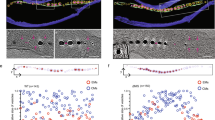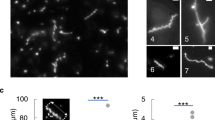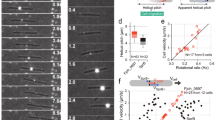Abstract
To navigate within the geomagnetic field, magnetotactic bacteria synthesize magnetosomes, which are unique organelles consisting of membrane-enveloped magnetite nanocrystals. In magnetotactic spirilla, magnetosomes become actively organized into chains by the filament-forming actin-like MamK and the adaptor protein MamJ, thereby assembling a magnetic dipole much like a compass needle. However, in Magnetospirillum gryphiswaldense, discontinuous chains are still formed in the absence of MamK. Moreover, these fragmented chains persist in a straight conformation indicating undiscovered structural determinants able to accommodate a bar magnet-like magnetoreceptor in a helical bacterium. Here, we identify MamY, a membrane-bound protein that generates a sophisticated mechanical scaffold for magnetosomes. MamY localizes linearly along the positive inner cell curvature (the geodetic cell axis), probably by self-interaction and curvature sensing. In a mamY deletion mutant, magnetosome chains detach from the geodetic axis and fail to accommodate a straight conformation coinciding with reduced cellular magnetic orientation. Codeletion of mamKY completely abolishes chain formation, whereas on synthetic tethering of magnetosomes to MamY, the chain configuration is regained, emphasizing the structural properties of the protein. Our results suggest MamY is membrane-anchored mechanical scaffold that is essential to align the motility axis of magnetotactic spirilla with their magnetic moment vector and to perfectly reconcile magnetoreception with swimming direction.
This is a preview of subscription content, access via your institution
Access options
Access Nature and 54 other Nature Portfolio journals
Get Nature+, our best-value online-access subscription
$29.99 / 30 days
cancel any time
Subscribe to this journal
Receive 12 digital issues and online access to articles
$119.00 per year
only $9.92 per issue
Buy this article
- Purchase on Springer Link
- Instant access to full article PDF
Prices may be subject to local taxes which are calculated during checkout






Similar content being viewed by others
Data availability
The data that support the findings of this study are available from the corresponding author upon reasonable request.
Code availability
The computer code used to analyse the PALM data is publicly available on https://github.com/GiacomoGiacomelli/mamy-cluster-analysis.
References
Uebe, R. & Schüler, D. Magnetosome biogenesis in magnetotactic bacteria. Nat. Rev. Microbiol. 14, 621–637 (2016).
Nordmann, G. C., Hochstoeger, T. & Keays, D. A. Magnetoreception-A sense without a receptor. PLoS Biol. 15, e2003234 (2017).
Popp, F., Armitage, J. P. & Schüler, D. Polarity of bacterial magnetotaxis is controlled by aerotaxis through a common sensory pathway. Nat. Commun. 5, 5398 (2014).
Kobayashi, A. et al. Experimental observation of magnetosome chain collapse in magnetotactic bacteria: sedimentological, paleomagnetic, and evolutionary implications. Earth Planet. Sci. Lett. 245, 538–550 (2006).
Frankel, R. & Blakemore, R. Navigational compass in magnetic bacteria. J. Magn. Magn. Mat. 15-18, 1562–1564 (1980).
Zahn, C. et al. Measurement of the magnetic moment of single Magnetospirillum gryphiswaldense cells by magnetic tweezers. Sci. Rep. 7, 3558 (2017).
Toro-Nahuelpan, M. et al. Segregation of prokaryotic magnetosomes organelles is driven by treadmilling of a dynamic actin-like MamK filament. BMC Biol. 14, 88 (2016).
Katzmann, E. et al. Magnetosome chains are recruited to cellular division sites and split by asymmetric septation. Mol. Microbiol. 82, 1316–1329 (2011).
Scheffel, A. et al. An acidic protein aligns magnetosomes along a filamentous structure in magnetotactic bacteria. Nature 440, 110–114 (2006).
Katzmann, E., Scheffel, A., Gruska, M., Plitzko, J. M. & Schüler, D. Loss of the actin-like protein MamK has pleiotropic effects on magnetosome formation and chain assembly in Magnetospirillum gryphiswaldense. Mol. Microbiol. 77, 208–224 (2010).
Orue, I. et al. Configuration of the magnetosome chain: a natural magnetic nanoarchitecture. Nanoscale 10, 7407–7419 (2018).
Ullrich, S., Kube, M., Schübbe, S., Reinhardt, R. & Schüler, D. A hypervariable 130-kilobase genomic region of Magnetospirillum gryphiswaldense comprises a magnetosome island which undergoes frequent rearrangements during stationary growth. J. Bacteriol. 187, 7176–7184 (2005).
Raschdorf, O., Müller, F. D., Posfai, M., Plitzko, J. M. & Schüler, D. The magnetosome proteins MamX, MamZ and MamH are involved in redox control of magnetite biomineralization in Magnetospirillum gryphiswaldense. Mol. Microbiol. 89, 872–886 (2013).
Müller, F. D. et al. The FtsZ-like protein FtsZm of M. gryphiswaldense likely interacts with its generic FtsZ homolog and is required for biomineralization under nitrate deprivation. J. Bacteriol. 196, 650–659 (2014).
Ding, Y. et al. Deletion of the ftsZ-like gene results in the production of superparamagnetic magnetite magnetosomes in Magnetospirillum gryphiswaldense. J. Bacteriol. 192, 1097–1105 (2010).
Siponen, M. I. et al. Structural insight into magnetochrome-mediated magnetite biomineralization. Nature 502, 681–684 (2013).
Tocheva, E. I., Li, Z. & Jensen, G. J. Electron cryotomography. Cold Spring Harb. Perspect. Biol. 2, a003442 (2010).
Kürner, J., Frangakis, A. S. & Baumeister, W. Cryo-electron tomography reveals the cytoskeletal structure of Spiroplasma melliferum. Science 307, 436–438 (2005).
Schüler, D., Uhl, R. & Baeuerlein, E. A simple light scattering method to assay magnetism in Magnetospirillum gryphiswaldense. FEMS Microbiol. Lett. 132, 139–145 (1995).
Borg, S., Hofmann, J., Pollithy, A., Lang, C. & Schüler, D. New vectors for chromosomal integration enable high-level constitutive or inducible magnetosome expression of fusion proteins in Magnetospirillum gryphiswaldense. Appl. Environ. Microbiol. 80, 2609–2616 (2014).
Grünberg, K. et al. Biochemical and proteomic analysis of the magnetosome membrane in Magnetospirillum gryphiswaldense. Appl. Environ. Microbiol. 70, 1040–1050 (2004).
Karimova, G., Pidoux, J., Ullmann, A. & Ladant, D. A bacterial two-hybrid system based on a reconstituted signal transduction pathway. Proc. Natl Acad. Sci. USA 95, 5752–5756 (1998).
Rothbauer, U. et al. Targeting and tracing antigens in live cells with fluorescent nanobodies. Nat. Methods 3, 887–889 (2006).
Borg, S. et al. An intracellular nanotrap redirects proteins and organelles in live bacteria. mBio 6, e02117-14 (2015).
Pollithy, A. et al. Magnetosome expression of functional camelid antibody fragments (Nanobodies) in Magnetospirillum gryphiswaldense. Appl. Environ. Microbiol. 77, 6165–6171 (2011).
Komeili, A., Li, Z., Newman, D. & Jensen, G. Magnetosomes are cell membrane invaginations organized by the actin-like protein MamK. Science 311, 242–245 (2006).
Scheffel, A. & Schüler, D. The acidic repetitive domain of the Magnetospirillum gryphiswaldense MamJ protein displays hypervariability but is not required for magnetosome chain assembly. J. Bacteriol. 189, 6437–6446 (2007).
Wagstaff, J. & Löwe, J. Prokaryotic cytoskeletons: protein filaments organizing small cells. Nat. Rev. Microbiol. 16, 187–201 (2018).
Oliva, M. A. et al. Features critical for membrane binding revealed by DivIVA crystal structure. EMBO J. 29, 1988–2001 (2010).
Bowman, G. R. et al. A polymeric protein anchors the chromosomal origin/ParB complex at a bacterial cell pole. Cell 134, 945–955 (2008).
Ebersbach, G., Briegel, A., Jensen, G. J. & Jacobs-Wagner, C. A self-associating protein critical for chromosome attachment, division, and polar organization in caulobacter. Cell 134, 956–968 (2008).
Kühn, J. et al. Bactofilins, a ubiquitous class of cytoskeletal proteins mediating polar localization of a cell wall synthase in caulobacter crescentus. EMBO J. 29, 327–339 (2010).
Gittes, F., Mickey, B., Nettleton, J. & Howard, J. Flexural rigidity of microtubules and actin filaments measured from thermal fluctuations in shape. J. Cell Biol. 120, 923–934 (1993).
Bennett, M. J., Choe, S. & Eisenberg, D. Domain swapping: entangling alliances between proteins. Proc. Natl Acad. Sci. USA 91, 3127–3131 (1994).
Janowski, R., Abrahamson, M., Grubb, A. & Jaskolski, M. Domain swapping in N-truncated human cystatin C. J. Mol. Biol. 341, 151–160 (2004).
Yang, F. et al. Crystal structure of cyanovirin-N, a potent HIV-inactivating protein, shows unexpected domain swapping. J. Mol. Biol. 288, 403–412 (1999).
Chinthalapudi, K., Rangarajan, E. S., Brown, D. T. & Izard, T. Differential lipid binding of vinculin isoforms promotes quasi-equivalent dimerization. Proc. Natl Acad. Sci. USA 113, 9539–9544 (2016).
Prutzman, K. C. et al. The focal adhesion targeting domain of focal adhesion kinase contains a hinge region that modulates tyrosine 926 phosphorylation. Structure 12, 881–891 (2004).
Heyen, U. & Schüler, D. Growth and magnetosome formation by microaerophilic Magnetospirillum strains in an oxygen-controlled fermentor. Appl. Microbiol. Biotechnol. 61, 536–544 (2003).
Falk, G. & Johansson, B. Complementation of a nitrogenase Fe-protein mutant of Rhodospirillum rubrum with the nif-plasmid pRD1 containing nif genes of Klebsiella pneumoniae. FEMS Microbiol. Lett. 19, 145–149 (1983).
Bertani, G. Studies on lysogenesis I: the mode of phage liberation by lysogenic Escherichia coli. J. Bacteriol. 62, 293–300 (1951).
Raschdorf, O., Plitzko, J. M., Schüler, D. & Müller, F. D. A tailored galK counterselection system for efficient markerless gene deletion and chromosomal tagging in Magnetospirillum gryphiswaldense. Appl. Environ. Microbiol. 80, 4323–4330 (2014).
Uebe, R. Mechanism and Regulation of Magnetosomal Iron Uptake and Biomineralisation in Magnetospirillum gryphiswaldense. PhD thesis, Ludwig-Maximilians-Universität (2011).
Lang, C. & Schüler, D. Expression of green fluorescent protein fused to magnetosome proteins in microaerophilic magnetotactic bacteria. Appl. Environ. Microbiol. 74, 4944–4953 (2008).
Gustafsson, M. G. et al. Three-dimensional resolution doubling in wide-field fluorescence microscopy by structured illumination. Biophys. J. 94, 4957–4970 (2008).
Wang, S., Moffitt, J. R., Dempsey, G. T., Xie, X. S. & Zhuang, X. Characterization and development of photoactivatable fluorescent proteins for single-molecule-based superresolution imaging. Proc. Natl Acad. Sci. USA 111, 8452–8457 (2014).
McKinney, S. A., Murphy, C. S., Hazelwood, K. L., Davidson, M. W. & Looger, L. L. A bright and photostable photoconvertible fluorescent protein. Nat. Methods 6, 131–133 (2009).
Bach, J. N., Giacomelli, G. & Bramkamp, M. Sample preparation and choice of fluorophores for single and dual color photo-activated localization microscopy (PALM) with bacterial cells. Methods Mol. Biol. 1563, 129–141 (2017).
Baddeley, A. J. & Gill, R. D. Kaplan–Meier estimators of interpoint distance distributions for spatial point processes. Ann. Stat. 25, 263–292 (1997).
Hanisch, K.-H. Some remarks on estimators of the distribution function of nearest-neighbour distance in stationary spatial point patterns. Ser. Stat. 15, 409–412 (1984).
Wickham, H ggplot2: Elegant Graphics for Data Analysis (Springer-Verlag, 2009).
R Core Team. R: A Language and Environment for Statistical Computing (R Foundation for Statistical Computing, 2014).
RStudio Team. RStudio: Integrated Development for R (RStudio, Inc., 2015).
Lemon, J. Plotrix: a package in the red light district of R. R-News 6, 8–12 (2006).
Mastronarde, D. N. Automated electron microscope tomography using robust prediction of specimen movements. J. Struct. Biol. 152, 36–51 (2005).
Martinez-Sanchez, A., Garcia, I., Asano, S., Lucic, V. & Fernandez, J. J. Robust membrane detection based on tensor voting for electron tomography. J. Struct. Biol. 186, 49–61 (2014).
Acknowledgements
We are grateful to G. Pfeifer (MPI of Biochemistry) for constant support with TEM and Cryo-ET, also to M. Turk for help with TEM. We thank B. Melzer, I. Mai and M. Klein for technical assistance, and we acknowledge T. Zwiener for providing the Mgryph ΔMAI strain. We are thankful to J. Peychl and B. Nitzsche at the MPI-CBG, light microscopy facility, for access to a GE DeltaVision OMX v4 Blaze microscope and to D.J. White of GE Healthcare-Cell Analysis, for applications support, technical specifications for publication and assistance with microscopy on the OMX. We also thank R. Zarivach, Ben-Gurion University of the Negev Beer Sheva, for helpful discussions. We are also grateful to M. Heider, Bayreuth Institute for Macromolecule Research, for technical assistance with scanning electron microscopy and we thank ChromoTek GmbH, Planegg-Martinsried, Germany for providing the mCherry-binding (RBP-) nanobody. Finally, we are deeply thankful to N. Albrecht for protein purification and help with DLS analysis. This work was supported by the Deutsche Forschungsgemeinschaft Grants Schu1080/9-2 (to D.S.), INST 86/1452 (to M.B.), INST 160/646-1, TRR174 project 5 (to M.B.) and has received funding from the European Research Council (ERC) under the European Union’s Horizon 2020 research and innovation programme (grant agreement no. 692637 (to D.S.)).
Author information
Authors and Affiliations
Contributions
M.T.-N., D.S. and F.D.M. conceived and designed research. M.T.-N., G.G., O.R., S.B. and F.D.M. performed experiments. M.T.-N. and F.D.M. performed SIM imaging. M.T.-N. and F.D.M. performed TEM and fluorescence microscopy. G.G. and M.T.-N. established and carried out PALM. G.G. created the single-molecule clustering algorithm and generated the PALM images. G.G., M.T.-N. and M.B. analysed PALM data. M.T.-N. performed cryo-ET; M.T.-N. and J.M.P. analysed the data. F.D.M. performed scanning electron microscopy with the help of M. Heider. M.T.-N. and M.B. analysed DLS data. M.T.-N. and F.D.M. analysed the whole dataset and wrote the manuscript. All authors discussed the results and commented on the manuscript.
Corresponding author
Ethics declarations
Competing interests
The authors declare no competing interests.
Additional information
Publisher’s note: Springer Nature remains neutral with regard to jurisdictional claims in published maps and institutional affiliations.
Supplementary information
Supplementary Information
Supplementary Figs. 1–13, Supplementary Notes, Supplementary Discussion, Supplementary Video legends, Supplementary Tables 1–3 and Supplementary References.
Supplementary Video 1
Cryo-ET and 3D rendering of a WT cell.
Supplementary Video 2
Cryo-ET and 3D rendering of a ΔmamY cell.
Supplementary Video 3
3D SIM of mCherry-MamY.
Rights and permissions
About this article
Cite this article
Toro-Nahuelpan, M., Giacomelli, G., Raschdorf, O. et al. MamY is a membrane-bound protein that aligns magnetosomes and the motility axis of helical magnetotactic bacteria. Nat Microbiol 4, 1978–1989 (2019). https://doi.org/10.1038/s41564-019-0512-8
Received:
Accepted:
Published:
Issue Date:
DOI: https://doi.org/10.1038/s41564-019-0512-8
This article is cited by
-
Silent gene clusters encode magnetic organelle biosynthesis in a non-magnetotactic phototrophic bacterium
The ISME Journal (2023)
-
The transcriptomic landscape of Magnetospirillum gryphiswaldense during magnetosome biomineralization
BMC Genomics (2022)
-
Membrane mediated phase separation of the bacterial nucleoid occlusion protein Noc
Scientific Reports (2022)
-
McaA and McaB control the dynamic positioning of a bacterial magnetic organelle
Nature Communications (2022)
-
Redox control of magnetosome biomineralization
Journal of Oceanology and Limnology (2021)



